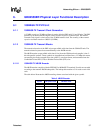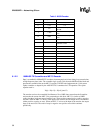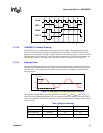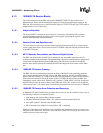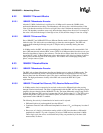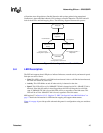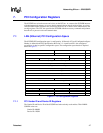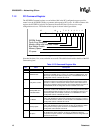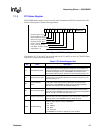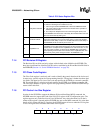
Datasheet
43
Networkin
g
Silicon — GD82559ER
All other activity is determined to be either data, link test pulses, Auto-Negotiation fast link pulses,
or the idle condition. When activity is detected, the carrier sense signal is asserted to the MAC.
6.2.3.3 10BASE-T Error Detection and Re
p
ortin
g
In 10 Mbps mode, the PHY unit can detect errors in the receive data. The following condition is
considered an error:
The receive pair’s voltage level drops to the idle state during reception before the end-of-frame
bit is detected (250 nanoseconds without mid-bit transitions).
6.2.4 10BASE-T Collision Detection
Collision detection in 10 Mbps mode is indicated by simultaneous transmission and reception. If
the PHY unit detects this condition, it asserts a collision indication to the CSMA/CD unit.
6.2.5 10BASE-T Link Inte
g
rit
y
The link integrity in 10 Mbps works with link pulses. The PHY unit senses and differentiates those
link pulses from fast link pulses and from 100BASE-TX idles. The 10 Mbps link pulses or normal
link pulses are driven in the transmit differential pair line but are 100 ns wide and have levels from
0 V to 5 V. The link beat pulse is also used to determine if the receive pair polarity is reversed. If it
is, the polarity is corrected internally.
6.2.6 10BASE-T Jabber Control Function
The PHY unit contains a jabber control function that inhibits transmission after a specified time
window when enabled. In 10 Mbps mode, the jabber timer is set to a value between 26.2 ms and 39
ms. If the PHY unit detects continuous transmission that is greater than this time period, it prevents
further transmissions from onto the wire until it detects that the MAC transmit enable signal has
been inactive for at least 314 ms.
6.2.7 10BASE-T Full Du
p
lex
The PHY unit supports 10 Mbps full duplex by disabling the collision function, the squelch test,
and the carrier sense transmit function. This allows the PHY unit to transmit and receive
simultaneously, achieving up to 20 Mbps of network bandwidth. The configuration can be achieved
through Auto-Negotiation. Full duplex should only be used in point-to-point connections (no
shared media).
6.3 Auto-Ne
g
otiation Functionalit
y
The PHY unit supports Auto-Negotiation. Auto-Negotiation is an automatic configuration scheme
designed to manage interoperability in multifunctional LAN environments. It allows two stations
with “N” different modes of communication to establish a common mode of operation. At power-
up, Auto-Negotiation automatically establishes a link that takes advantage of an Auto-Negotiation
capable device. An Auto-Negotiation capable device can detect and automatically configure its
port to take maximum advantage of common modes of operation without user intervention or prior
knowledge by either station. The possible common modes of operation are: 100BASE-TX,
100BASE-TX Full Duplex, 10BASE-T, and 10BASE-T Full Duplex.





